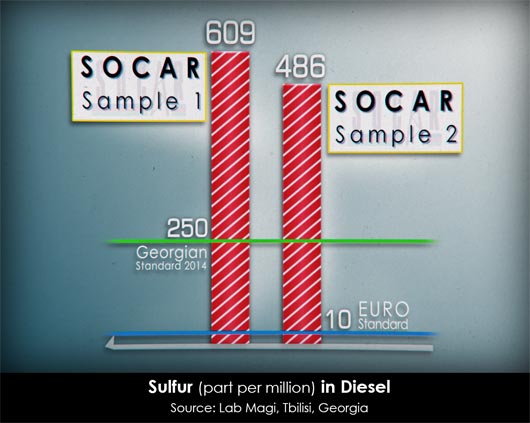The tests show that the dirtiest fuel is coming from neighboring Azerbaijan, which may have policy implications for Georgia, since the State Oil Company of Azerbaijan Republic (SOCAR), which exports the fuel, is Georgia’s largest taxpayer. A sample of SOCAR diesel fuel tested 60 times higher than the current European standard.
Irakli Zubitashvili, head of the Quality Assurance Department for SOCAR Petroleum Georgia, refused numerous requests to discuss these laboratory results.
SOCAR is wholly owned by the Government of Azerbaijan. SOCAR Energy Georgia, which is 51 percent owned by SOCAR and 49 percent owned by two United Arab Emirate-based companies (Heritage General Trading FZE and Petro-Trans FZCO), is the largest taxpayer in the country (about US$74.271 million in 2013). SOCAR Energy Georgia controls the natural gas distribution network in 30 regions of Georgia and operates the Kulevi Oil Terminal at Georgia’s Black Sea port of Poti.
The Azerbaijani company also has an outsized cultural footprint in Georgia, as its public service funding supports the Georgian Olympic Committee and Georgia’s football and chess federations.
Studio Monitori, an Organized Crime and Corruption Reporting Project (OCCRP) partner, investigated where Georgia buys its fuel, what the country’s clean-air standards are, how they are enforced, what is actually in the various brands of fuel sold, how after-market modifications of cars affect air quality, and whether there may be an impact on public health.
How lax are Georgia’s standards for pollutants? In some cases, the rules allow concentrations 20 times higher than European standards. Fuel samples collected by Studio Monitori show that some brands of fuel sold in Georgia exceed even those lax standards by significant amounts.
Monitori reporters collected samples of gasoline and diesel fuel from five major companies in Georgia: SOCAR, Rompetrol, Lukoil, Wissol and Gulf. While not all samples violated Georgia’s lax standards, they greatly exceeded European standards .
The samples were tested for a variety of components by LTD Magic Lab, an independent chemical analysis facility in Tbilisi.
The dirtiest fuel was SOCAR diesel. The current European standard for sulfur in diesel is 10 parts per million (ppm). On January 1, 2014, Georgia changed its allowable standard for sulfur in diesel fuel from 300 ppm to 200 ppm .
Samples of diesel fuel from two different SOCAR stations were tested. One sample measured at 609 ppm of sulfur and the second sample measured at 486 ppm.
Records show that Georgia imports three out of every four liters of diesel fuel from SOCAR – or more than 250 million kg, according to the Georgia Revenue Service.
Regular-grade gasoline is used by about 70 percent of Georgia drivers. The European standard for sulfur is 10 ppm, the Georgian standard is 150 ppm. The lab test for SOCAR regular-grade gasoline showed a sulfur level of 166 ppm.
There are several reasons why dirty fuel is an important issue in Georgia:
According to the Ministry of Environment, automobiles are responsible for 70 percent of air pollution in Georgia, and 95 percent of air pollution in the capital city of Tbilisi. These are unreliable figures, because air pollution testing in Georgia is almost non-existent. There is only one antiquated testing booth in the entire city of Tbilisi (population one million) that attempts to measure the level of five pollutants: sulfur, carbon monoxide, lead, ozone and dust.
There are more than 900,000 vehicles registered in Georgia. According to the Ministry of Environment, 91 percent of these vehicles are more than 10 years old. Most are imported second-hand from Japan, the United States and Germany. Older exhaust systems emit more pollutants into the air.
Former President Mikheil Saakashvili ended all automobile inspections in Georgia in 2004, saying the system was too prone to corruption. Georgia is scheduled to resume automobile inspections in 2015 .
Catalytic converters are designed to reduce carbon monoxide emissions from motor vehicles by as much as 10 percent but may reduce gas mileage. Because there are currently no vehicle inspections, many Georgia drivers remove the converters to reduce fuel usage. It is unclear whether the 2015 inspections will mandate catalytic converters. When inspections resume, Georgia will set a limit for carbon monoxide of 3.5 percent of total emissions. The European standard is 0.5 percent.
Respiratory diseases are on the rise in Georgia. According to Amiran Gamkrelidze, general director of the National Center for Disease Control, there were 337,639 new cases of severe respiratory infections in 2012 out of an estimated population of four million in Georgia. That is a 10.7 percent increase in severe respiratory conditions in one year. According to these same statistics, 52.4 percent of those who became ill in 2012 were children.
The Ministry of Environment has developed an air pollution control program that includes a provision for monitoring fuel quality. It was supposed to take effect on January 1, 2014. But Parliament has yet to approve the legislation.
Meanwhile, back in SOCAR’s home country of Azerbaijan, clean fuel standards are improving. As of April 1, no automobiles more than 10 years old can be imported, and only Euro-4 grade gasoline which meets the low European standards for pollutants can be sold.






